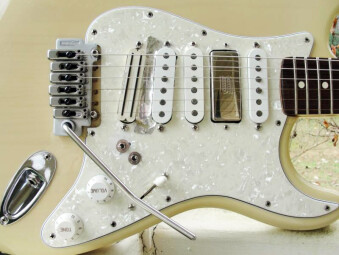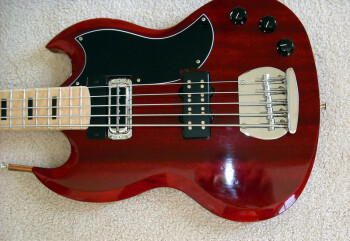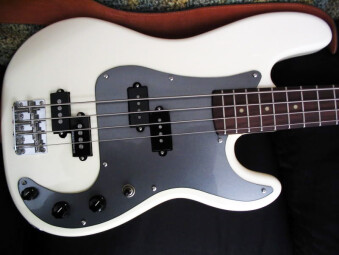Up to now we have been talking about what's inside the pickups, but today we'll deal with the physical appearance.
Even though pickup formats are pretty standard, you shouldn’t take for granted what’s inside a pickup simply by its looks. Furthermore, pickup formats are usually named after a given instrument or how a pickup is built, which can be a little confusing. The name of the pickup actually defines the form of the pickup itself and the pickup cavity on the instrument where it’s to be mounted.
Pickup lines
The most common pickup types for guitar are the humbucker and single-coil.
The humbucker format refers to the somewhat big, rectangular pickup design initially introduced by Gibson with the PAF (see the previous installment of this series for more about that). There are models both with and without a metallic cap to conceal (or not) the pole pieces.
Inside this type of pickup, which almost any pickup manufacturer makes, there is usually a…humbucker, electronically speaking, that is, which, as we saw before, consists of two coils generally wired in series. However, lots of brands offer splittable or switchable (in series/parallel) versions of their humbuckers, which allow you to get a single-coil sound.
Finally, some manufacturers of replacement pickups offer single-coil pickups (like a P90, for instance) in humbucker format. These pickups are aimed at guitarists whose instrument doesn’t have a cavity for a single-coil pickup but would rather use a single-coil instead of a humbucker.
For its part, the term single-coil pickup refers to the Stratocaster single-coil or Telecaster bridge pickup types. But just because it looks like a standard single coil model from the outside, it doesn’t mean it is. For example, you can find pickups (with pole pieces, blades…) that aim to provide a humbucker sound on an instrument whose cavities are for single coil pickups. These models don’t require you to modify the guitar to fit a “real” humbucker, in the Gibson sense of the word (namely a pickup that is twice as big). Ironically, these humbuckers in single-coil format can also be split to sound like a single-coil.
And there are also other weird formats, like the “lipstick” (the neck pickup of a Telecaster or the ones on Danelectro guitars…), the P90 (a rectangulair design very similar to a humbucker but a bit narrower, which fits a typical single coil from… Gibson!), the Fender Jazzmaster pickups (similar to the aforementioned P90), Gretsch and Rickenbacker pickups…
Down low
For bass players it’s even more complicated, because there are more “basic” formats.
The Precision Bass format refers to the pickup used on the instrument of the same name, designed by Leo Fender. The PB is a pickup with two pole pieces per string (split into two parts and wired in series to cancel hum), which don’t pick up the vibrations of the same string at the same time, so despite its humbucker design, it actually sounds like a signal-coil. Under this typical dual-cap design you can now find almost anything, from pole-piece to blade pickups in single-coil or humbucker format.
The Jazz Bass format is similar in spirit to the PB: It’s originally a single-coil design (a long and narrow rectangle with dual pole pieces) typically used on the bass designed by Leo Fender. This is probably the most common pickup design in the bass world and under the hood it can conceal anything you can think of, from single-coils to humbuckers, splittable or not, with pole-piece or blades, both covered and exposed.
The MusicMan format refers to the huge dual-pole piece row design typical of a bass designed, once again(!), by Leo Fender. Under the cap is usually a humbucker, although they can have their own particularities (splittable, in series/parallel, with phantom coils).
The soapbar is the most recent format to come along for bass guitar. Under this soapy name conceals a rectangular pickup usually with (although not always) covered pole pieces, which makes it look like a big black…soap bar. Although usually big, there is no standard size for this sort of pickup, they can vary quite a bit in terms of length and width and have either rounded or squared edges. There are two models that are the most common: one which is not too large (like an EMG 40, the pickup that popularized these dimensions) with squared edges, and another one that is bigger and features rounded edges (like a Bartolini P9, for the same reasons stated above). Many manufacturers use these formats as reference, although some others use custom dimensions and shapes, like Sandberg who have parallelepipedic pickups or Delano with its oval-shaped ones. Inside a soapbar you can find anything, from single-coils to quad-coils, humbuckers, splittable (in all senses), pole-piece or blade magnets, exposed or not, and even other types of pickups, like a Jazz Bass or a Precision, disguised under a more modern look!
Among bass guitars you can find many other more or less widespread formats, starting with the Rickenbackers, which have always been unlike anything else.
The relativity of standards
Be careful with the notion of a “standard pickup format.” Nothing is really standard in this domain. Two pickups with the same format but from different manufacturers, and even from the same manufacturer but from different periods, may differ slightly. These slight variations make a huge difference when it comes to making the mounting of pickups a breeze or a real pain resulting in the need of files, routers and an accidental shaving. Many instruments throughout history have ended up looking like a Frankenstein of sorts. So, if you don’t want your guitar to end up like that and don’t have any intention of becoming an improvised guitar maker, take all necessary precautions with dimensions when you plan to perform a surgical operation on your instrument.
What’s more, the strings of guitars and basses aren’t strictly parallel between them. The spacing between strings is larger the closer you get to the bridge, which is something taken into account for pickup formats. For example, the two pickups of a Jazz Bass seem to be identical, but they are slightly different (the bridge pickup is larger by a couple of millimeters), and the pole pieces are farther apart on the bridge pickup. And since there are no rules, blade pickup manufacturers who don’t want to deal with the issues of spacings between pole pieces offer JB pickup pairs where both are exactly the same size, for modern instruments with narrower string spacings at the bridge.
As for guitar players, the presence of a tremolo at the bridge, especially a Floyd Rose, has a significant impact on the spacing between strings and ought to be taken into account when measuring the dimensions of replacement pickups.




